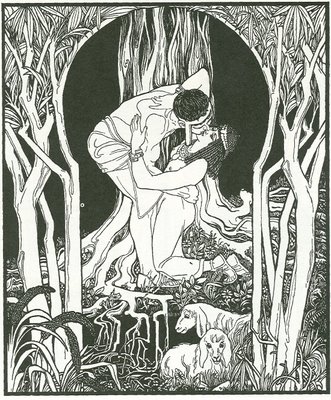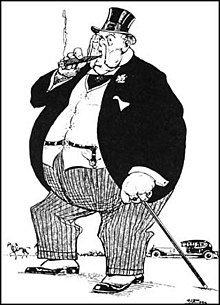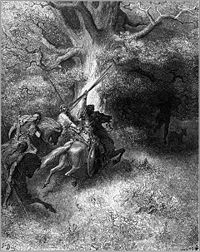
A visualization of the Bible’s “Song of Songs…”
Welcome to “read the Bible – expand your mind:”
For more on expanding your mind and horizons, see the Introduction.
The theme here is that taking the Bible literally is a good place to start. But to be all that you can be in this earthly pilgrimage, you need to explore the “mystical side of Bible reading.*”
That’s what this blog is about. Exploring that mystical side of the Bible.
Or see Some basics, on the Three Great Promises of Jesus: 1) He’ll accept anyone who comes to Him; 2) He wants us to live abundantly; and 3) He wants us do greater miracles than He did.
In the meantime:
 I’m leaving town on Monday, August 10, and won’t be back until August 27. (A matter of some “unfinished business,” canoe-trip-wise.) So here’s an analysis of the Bible readings for Sunday, August 16, 23 and 30.
I’m leaving town on Monday, August 10, and won’t be back until August 27. (A matter of some “unfinished business,” canoe-trip-wise.) So here’s an analysis of the Bible readings for Sunday, August 16, 23 and 30.
(You can see the full readings for all three Sundays at Twelfth Sunday after Pentecost – Proper 15, Thirteenth Sunday after Pentecost – Proper 16, and Fourteenth Sunday after Pentecost – Proper 17.)
In the readings discussed below, we see a rare Biblical glimpse on the beauty of sexual love, and on David finally dying, or “sleeping with his ancestors.” They also tell about Jesus as both the Bread of Life and as the Light of the World.
But first, a note that on August 16 there’s a switch in the Old Testament readings.
Up until August 9, those readings were from the Second Book of Samuel. On August 16 – and 23 – they switch to the First Book of Kings. The two books “of Kings” were originally one, but they were so long that they had to be put on two different scrolls. (The ancient Hebrews didn’t have “books” as we know them. Their books were actually scrolls.)
The Two Book of Kings present the Bible view of the “history of ancient Israel and Judah from the death of David to the release of his successor Jehoiachin from imprisonment in Babylon.”
 Then for August 30 the OT reading changes again, from Kings to the “Song of Solomon” or Song of Songs. (After that, during the month of September the Old Testament readings are from the Book of Proverbs.)
Then for August 30 the OT reading changes again, from Kings to the “Song of Solomon” or Song of Songs. (After that, during the month of September the Old Testament readings are from the Book of Proverbs.)
The “Song of Songs” is unique. It doesn’t refer to The Law (illustrated at right), or to the Covenant, or to Yahweh. And the song doesn’t teach wisdom “in the manner of Proverbs or Ecclesiastes:”
Instead, it celebrates sexual love. It gives “the voices of two lovers, praising each other, yearning for each other, proffering invitations to enjoy.” The two are in harmony, each desiring the other and rejoicing in sexual intimacy; the women (or “daughters”) of Jerusalem form a chorus to the lovers … whose participation in the lovers’ erotic encounters facilitates the participation of the reader.
But more about that later.
The OT reading for August 16 – 1 Kings 2:10-12; 3:3-14 – starts: “David slept with his ancestors, and was buried in the City of David,” that is, Jerusalem. (This was after he’d been King of Israel for 40 years.) It then introduces Solomon – David’s son – as the new King. (Though not without a bit of drama, in the form of a struggle over the succession.)
Wikipedia said Solomon was known most for his wisdom, and the reading shows Solomon praying for such wisdom. God responded by giving him “wisdom plus:”
It pleased the Lord that Solomon had asked this. God said to him, “Because you have asked this, and have not asked for yourself long life or riches … I now do according to your word… I give you also what you have not asked, both riches and honor all your life; no other king shall compare with you… (E.A.)
All of which provides a wonderful object lesson in the proper way to pray to God.
 The OT reading for August 23 – 1 Kings 8:(1, 6, 10-11), 22-30, 41-43 – includes a similar prayer with Solomon praising God. He did this in the process of bringing the Ark of the Covenant back to the First Temple in Jerusalem.
The OT reading for August 23 – 1 Kings 8:(1, 6, 10-11), 22-30, 41-43 – includes a similar prayer with Solomon praising God. He did this in the process of bringing the Ark of the Covenant back to the First Temple in Jerusalem.
( 1st Kings 7 described the process of building the Temple. Note that the Ark had been with David when he fled Jerusalem “at the time of Absalom‘s conspiracy.” It was later returned, and during the 13 years that Solomon built the Temple, it was kept in “a special inner room, named Kodesh Hakodashim, or Holy of Holies. See 1st Kings 6:19.)
The OT reading for August 30 – Song of Solomon 2:8-13 – follows the Introduction (1:1–6) and a “Dialogue between the lovers (1:7–2:7).” In this reading the “woman recalls a visit from her lover (2:8–17).” Passages include “My beloved is like a gazelle or a young stag,” and the beloved speaking to her, “Arise, my love, my fair one, and come away.” (Wikipedia noted the Christian tradition, “appreciating the literal meaning of a romantic song between man and woman,” but also seeing the poem as “an allegory of Christ (the bridegroom) and his Church (the bride).”)
The psalms for these three weeks include Psalm 111, Psalm 84, and Psalm 45:1-2, 7-10. The International Bible Commentary (IBC) described Psalm 84 as “A pilgrim’s testimony.” It added that the psalm rivals Paul’s letter to the Philippians as an expression of spiritual joy.” The psalmist finds in God “true security and abundant blessing, to which a life of [attempted] moral integrity is the key according to the covenant.” (See “the Covenant, above.)
(“Attempted” in brackets is a reminder that we’re all still “works in progress,” and will remain so…)
And speaking of weddings, the IBC said Psalm 45 was a “wedding song for a king and his bride.” Continuing the theme begun in Song of Songs – above – Psalm 45:2 reads: “You are the fairest of men; grace flows from your lips, because God has blessed you for ever.” And Psalm 45:8 reads: “All your garments are fragrant with myrrh, aloes, and cassia, and the music of strings from ivory palaces makes you glad.”
The New Testament readings are Ephesians 5:15-20, Ephesians 6:10-20, and James 1:17-27.
As noted in Wikipedia, Ephesians 5:15-20 is part of Paul’s discourse of instructions about ordinary life and different relationships. But in Ephesians 6:10-20, Paul moves on to the “imagery of spiritual warfare (including the metaphor of the Armor of God).” And James begins with an introduction, with an additional instruction to “be doers of the word, and not merely hearers who deceive themselves.” (James 1:22.)
That simple phrase set up a spiritual battle that continues even to this day. See Mary and Martha of Bethany: “the debate over which is the better path – faith or works – has been going for most if not all the 2,000 years since the Church was born. See Faith and Works.”
 Martin Luther for one characterized James’ letter as an ‘epistle of straw,'” mostly – he thought – because it supposedly conflicted “with Paul on the doctrine of justification.” (Like I said, that spiritual battle continues “even to this day,” but maybe the answer isn’t “either-or,” but rather “both.” See Mary and Martha.) Note also that readings from James will continue throughout the month of September.
Martin Luther for one characterized James’ letter as an ‘epistle of straw,'” mostly – he thought – because it supposedly conflicted “with Paul on the doctrine of justification.” (Like I said, that spiritual battle continues “even to this day,” but maybe the answer isn’t “either-or,” but rather “both.” See Mary and Martha.) Note also that readings from James will continue throughout the month of September.
The Gospel readings are John 6:51-58, John 6:56-69, and – in another switch – to Mark 7:1-8, 14-15, 21-23. In the readings from John’s Gospel, Jesus continues His Bread of Life Discourse:
In the Christological context, the use of the Bread of Life title is similar to the Light of the World title in John 8:12 where Jesus states: “I am the light of the world: he who follows me shall not walk in darkness, but shall have the light of life.” These assertions build on the Christological theme of John 5:26 where Jesus claims to possess life just as the Father does and provide it to those who follow him
See also The readings for August 9, which added that “part of that ‘light of life’ or ‘bread of life’ approach is to know how to process anger and/or misunderstandings…”
The Gospel for August 30 includes Jesus being criticized by “Pharisees and some of the scribes.” (They saw some disciples eating with “unwashed hands.”) He responded by quoting Isaiah 29:13 and concluding, “You abandon the commandment of God and hold to human tradition.” Incidentally, Mark 7:9 is skipped over in this reading, but in it Jesus continued, “You have a fine way of setting aside the commands of God in order to observe your own traditions!”
Another example of the proper way not to approach God…

“Woe unto You, Scribes and Pharisees, hypocrites!“
The upper image is courtesy of religion.lilithezine.com/The-Song-of-Solomon. The article doesn’t have a readily-identifiable attribution, but it appears to be the work of Aubrey Beardsley. Beardsley (1872-1898) was a noted English illustrator and author:
His drawings in black ink, influenced by the style of Japanese woodcuts, emphasized the grotesque, the decadent, and the erotic. He was a leading figure in the Aesthetic movement… [His] contribution to the development of the Art Nouveau and poster styles was significant, despite the brevity of his career before his early death from tuberculosis.
See Wikipedia, the free encyclopedia.
The canoe image is courtesy of Canoe – Wikipedia. Caption: “Voyageur canoe shooting the rapids.”
Re: First and Second Kings. The consensus is that First and Second Chronicles repeat much of the material in First and Second Kings. See Wikipedia: “Much of the content of Chronicles is a repetition of material from other books of the Bible, from Genesis to Kings.” But see also Chronicles and Kings – A Comparison – Mark Haughwout, and/or The Relationship between … Kings and Chronicles.
The “Law” image is courtesy of Torah – Wikipedia. The caption: “Presentation of The Torah (1860) –Museum of Jewish Art and History.” The Torah is also known as The Law:
Christian scholars usually refer to the first five books of the Hebrew Bible as the “Pentateuch” … or as the Law, or Law of Moses. Muslims refer to the Torah as Tawrat (توراة, “Law”), an Arabic word for the revelations given to the Islamic prophet Musa (موسى, Moses in Arabic).
The “Solomon dedication” image is courtesy of the First Temple Wikipedia article. The caption: “In an artistic representation, King Solomon dedicates the Temple at Jerusalem (painting by James Tissot or follower, c. 1896–1902).”
The Martin Luther image is courtesy of Wikipedia, the free encyclopedia. The caption: “Luther as a friar, with tonsure.” See also Tonsure – Wikipedia, referring to practice “in medieval Catholicism, abandoned by papal order in 1972.”
The lower image is courtesy of Woes of the Pharisees – Wikipedia. The full caption: “James Tissot, Woe unto You, Scribes and Pharisees, Brooklyn Museum.” See also Light of the World – Wikipedia. The quote including “hypocrites” is from Matthew 23:14.
 Jesus, sharing the “Bread of Life” at Emmaus – as discussed in the Gospel for August 9…
Jesus, sharing the “Bread of Life” at Emmaus – as discussed in the Gospel for August 9…
 But Absalom was eventually killed in battle, despite David’s orders that he not be harmed. The death of Absalom is shown at left, courtesy of
But Absalom was eventually killed in battle, despite David’s orders that he not be harmed. The death of Absalom is shown at left, courtesy of  The New Testament reading –
The New Testament reading – 
 Re: “all that you can be.” See
Re: “all that you can be.” See 


